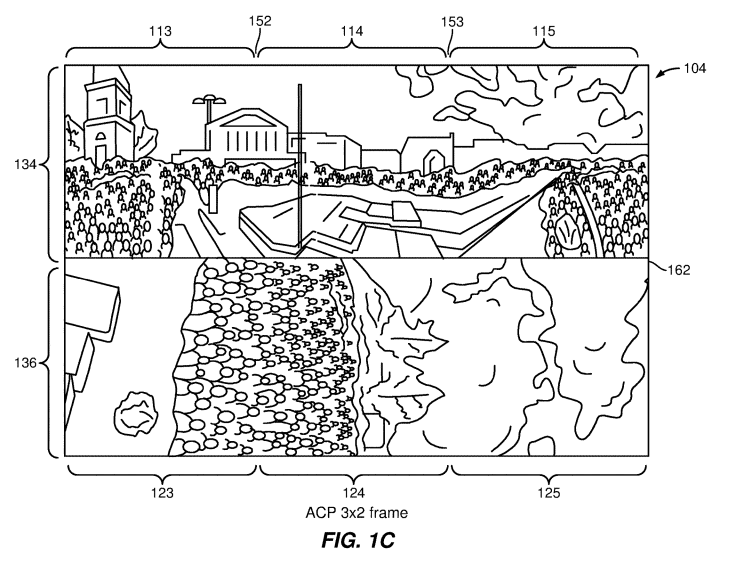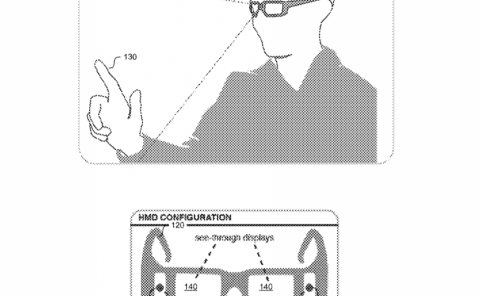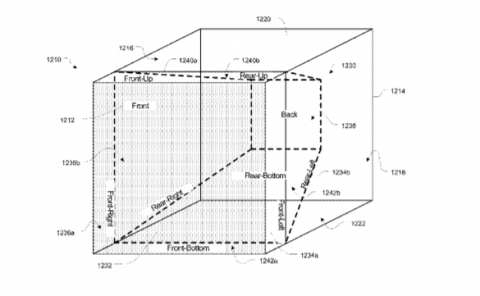Qualcomm Patent | Reducing Seam Artifacts in 360-Degree Video
Patent: Reducing Seam Artifacts in 360-Degree Video
Publication Number: 20190007684
Publication Date: 2019-01-03
Applicants: Qualcomm

Abstract
Provided are systems and methods for processing 360-degree video data by obtaining at least one 360-degree rectangular formatted projected picture; detecting a projection boundary in the at least one 360-degree rectangular formatted projected picture; disabling at least one of an in-loop filtering, an intra-prediction, or an inter-prediction, based on detecting the at least one 360-degree rectangular formatted projected picture comprises the projection boundary; and generating an encoded video bitstream.
Background
Video coding standards include Joint Video Exploration Team (JVET) of MPEG and VCEG, ITU-T H.261, ISO/IEC MPEG-1 Visual, ITU-T H.262 or ISO/IEC MPEG-2 Visual, ITU-T H.263, ISO/IEC MPEG-4 Visual, ITU-T H.264 (also known as ISO/IEC MPEG-4 AVC), including its Scalable Video Coding (SVC) and Multiview Video Coding (MVC) extensions and ITU-T H.265 (also known as ISO/IEC MPEG-4 HEVC) with its extensions.
Summary
In various implementations, methods, devices, apparatus, and computer-readable media for processing 360-degree video data to obtain better coding efficiency are described herein.
A method can include obtaining at least one 360-degree rectangular formatted projected picture; detecting a projection boundary in the at least one 360-degree rectangular formatted projected picture; disabling at least one of an in-loop filtering, an intra-prediction, or an inter-prediction, based on detecting the at least one 360-degree rectangular formatted projected picture comprises the projection boundary; and generating an encoded video bitstream.
In some embodiments, the method can include determining that the 360-degree rectangular formatted projected picture contains a first picture half and a second picture half, wherein the first picture half and the second picture half are separated by a projection boundary; and disabling in-loop filtering in response to determining that the 360-degree rectangular formatted picture contains the first picture half and the second picture half.
In further embodiments, disabling in-loop filtering further comprises: disabling in-loop filtering for the entire at least one 360-degree rectangular formatted projected picture by disabling in-loop filtering in parameter sets for the at least one 360-degree rectangular formatted projected picture.
In additional embodiments, disabling in-loop filtering further comprises: disabling in-loop filtering within a slice of the at least one 360-degree rectangular formatted projected picture.
In some implementations, disabling in-loop filtering further comprises: identifying at least two coding tree units (CTUs) adjacent one another about the projection boundary; and disabling in-loop filtering for the identified at least two CTUs adjacent one another about the projection boundary.
In further implementations, disabling in-loop filtering further comprises: identifying at least two coding tree units (CTUs) adjacent one another about the projection boundary; and disabling in-loop filtering for the identified at least two CTUs by disabling sample adaptive offset (SAO) band offsets or SAO edge offsets across the at least two CTUs.
In additional implementations, the 360-degree rectangular formatted projected picture is a 3.times.2 packed projected picture.
In some embodiments, the 360-degree rectangular formatted projected picture is a 6.times.1 packed projected picture.
In further embodiments, the method can include determining the 360-degree rectangular formatted projected picture comprises at least a first region and a second region, wherein the first region and second region are separated by the projection boundary; determining a plurality of coding tree units (CTUs) across the 360-degree rectangular formatted projected picture; determining a plurality of coding units (CUs) from within the plurality of CTUs; performing intra-frame prediction across at least two of the plurality of CUs; identifying a first CU located within the first region and a second CU located within the second region; and disabling intra-frame prediction across the first CU and second CU, based on identifying the first CU located within the first region and the second CU located within the second region.
In additional embodiments, the first CU and second CU share a common boundary, and the common boundary is the projection boundary.
In some implementations, the method can include determining a 360-degree rectangular formatted projected picture QP value for the 360-degree rectangular formatted projected picture; and wherein disabling intra-frame prediction across the first CU and second CU is performed only when the 360-degree rectangular formatted projected picture QP value is above a threshold QP level.
In further implementations, the threshold QP level is 20.
In additional implementations, obtaining the at least one 360-degree rectangular formatted projected picture comprises obtaining a first temporal 360-degree rectangular formatted projected picture and a second temporal 360-degree rectangular formatted projected picture, wherein the first temporal 360-degree rectangular formatted projected picture temporally precedes the second temporal 360-degree rectangular formatted projected picture, wherein the first temporal 360-degree rectangular formatted projected picture comprises at least a first region, and wherein the second temporal 360-degree rectangular formatted projected picture comprises at least a second region, wherein the first region and second region are located on opposite sides of the projection boundary, the method can further include: determining a plurality of first temporal coding tree units (CTUs) across the first temporal 360-degree rectangular formatted projected picture; determining a plurality of second temporal coding tree units (CTUs) across the second temporal 360-degree rectangular formatted projected picture; determining a plurality of first temporal coding units (CUs) from within the plurality of first temporal CTUs; determining a plurality of second temporal coding units (CUs) from within the plurality of second temporal CTUs; performing inter-frame prediction across at least one of the CUs from the plurality of first temporal CUs and at least one CU from the plurality of second temporal CUs; identifying a first temporal CU located within the first region and a second temporal CU located within the second region; and disabling inter-frame prediction across the first temporal CU and the second temporal CU based on the identifying a first temporal CU located within the first region and a second temporal CU located within the second region.
In some embodiments, disabling inter-frame prediction across the first temporal CU and the second temporal CU, further comprises not performing motion based prediction across the first temporal CU and the second temporal CU.
In further embodiments, the projection boundary comprises a boundary wherein a first region and a second region disposed adjacent to one another along the boundary in a projection domain are not disposed adjacent to one another in a spatial domain.
A device can include a memory and a processor configured to perform a method that includes obtaining at least one 360-degree rectangular formatted projected picture; detecting a projection boundary in the at least one 360-degree rectangular formatted projected picture; disabling at least one of an in-loop filtering, an intra-prediction, or an inter-prediction, based on detecting the at least one 360-degree rectangular formatted projected picture comprises the projection boundary; and generating an encoded video bitstream.
A computer-readable medium can a non-transitory computer-readable medium storing a program containing instructions that, when executed by a processor of a device, cause the device to perform a method that includes obtaining at least one 360-degree rectangular formatted projected picture; detecting a projection boundary in the at least one 360-degree rectangular formatted projected picture; disabling at least one of an in-loop filtering, an intra-prediction, or an inter-prediction, based on detecting the at least one 360-degree rectangular formatted projected picture comprises the projection boundary; and generating an encoded video bitstream.
An apparatus can include means for obtaining at least one 360-degree rectangular formatted projected picture; means for detecting a projection boundary in the at least one 360-degree rectangular formatted projected picture; means for disabling at least one of an in-loop filtering, an intra-prediction, or an inter-prediction, based on detecting the at least one 360-degree rectangular formatted projected picture comprises the projection boundary; and means for generating an encoded video bitstream.



